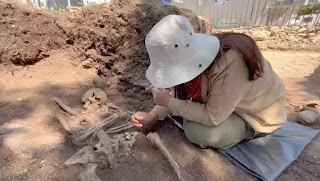O rosto foi reconstituído com base num crânio com uma deformação misteriosa descoberto numa necrópole do século 3 d.C., no sítio arqueológico de Juliopolis, uma cidade antiga localizada na atual província de Ancara.
Trata-se do único crânio deformado datado do período romano descoberto na Anatólia. A sepultura continha restos mortais de um total de sete indivíduos, dos quais dois apresentavam estranhas marcas de deformação propositada nos crânios.
O local foi datado com base em moedas e brincos de bronze e as características morfológicas do crânio sugeriram o seu sexo e datação, com os graus de fechamento da sutura craniana indicando que terá morrido jovem, quando tinha entre 25 e 35 anos de idade.

A reconstituição foi conduzida pelo designer 3D brasileiro Cicero Moraes, em colaboração com os arqueólogos Evren Sertalp e Erge Butün, da Universidade de Hacettepe, em Ancara, na Turquia. Os resultados foram publicados num artigo no site Research Square, a 17 de agosto.
Deformação misteriosa
Os autores do estudo identificaram uma deformação no crânio da mulher de Juliópolis resultante da "aplicação de elementos mais flexíveis, como ligaduras, fitas ou tiras transversais". Essas amarras foram unidas a "outros materiais não plásticos" na parte de trás da cabeça, segundo descrevem no artigo.
Os pesquisadores apontam ainda que dois objetos duros de aproximadamente 5 cm de diâmetro foram utilizados logo acima da testa da mulher. Além disso, havia duas marcas de bandagens na sua caixa craniana.
Recriando o rosto de Juliópolis
Os autores do estudo criaram uma modelagem 3D do crânio por fotogrametria. Isto é, o fóssil foi colocado numa placa giratória e fotografado de diferentes ângulos. Um total de 113 fotografias foram tiradas, sendo que 95 foram utilizadas para o modelo.
No entanto, faltava no crânio a mandíbula e vários dentes superiores. Essas partes foram recriadas digitalmente com base numa biblioteca virtual de doadores que contém imagens de outros ossos.
Uma malha 3D de um doador virtual apropriado foi usada para substituir a mandíbula e os dentes perdidos da mulher turca. A equipa realizou a reconstrução facial utilizando o software Blender com o complemento OrtogOnBlender e o seu submódulo ForensicOnBlender.
“A projeção e a estrutura da face foram determinadas pelos dados adquiridos nas medidas do crânio”, descrevem os pesquisadores, que apresentaram os resultados em escala de cinza e em cores. “Por fim, foi criado o detalhe do rosto e do cabelo, e as imagens finais foram geradas”, acrescentam.
Com a aproximação facial do crânio, os autores pretendem aumentar ainda mais a visibilidade e o reconhecimento do fóssil. “A reconstrução facial deste crânio feminino deformado demonstrará como o povo de Juliópolis do passado pode ter sido”, afirma a equipa. “Além disso, [o estudo] mostra como completar as lacunas de uma amostra – como a mandíbula, neste caso – utilizando dados digitais apropriados, o que pode servir de exemplo para estudos futuros”, concluem.
(Fonte: Galileu)






